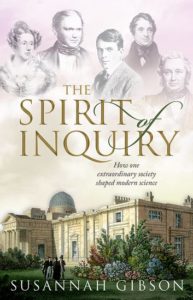John Philoponus, in his Commentary on the Soul, records that above the entrance to Plato’s Academy was inscribed ἀγεωμέτρητος μὴ εἰσίτω (“Let None But Geometers Enter Here”). It may have been equally appropriate to have posted a sign reading “A Knowledge of Mathematics Is Required” above the doorways to the early meeting places of the Cambridge Philosophical Society. Established in 1819 by a group of young “Cambridge men,” some of whose names you may have previously heard – such as Adam Sedgwick, John Stevens Henslow, and John Herschel – for the sharing and discussion of new discoveries, particularly in areas of experimental science, the Society required all fellows to hold a Cambridge degree, and to hold a Cambridge degree at that time meant that one had sat and passed Cambridge University’s Mathematical Tripos.
The Tripos, for those unfamiliar, was named for the three-legged stool upon which the one being examined sits while being tested on his (Cambridge was exclusively open to men at this time) knowledge of mathematics. For students of the university, the results of the Tripos very much determined the future course of one’s life. Achieving the highest score each year earned one the title of Senior Wrangler and thus very likely the offer of a life fellowship at the university. Those who also placed highly were ranked at their respective relative level for that year (Second Wrangler, Third Wrangler, etc.), and received accolades and rewards accordingly. Yet what may surprise most who are unfamiliar with the history of the university is the fact that the focus upon and rigorous study of mathematics at Cambridge in those days was not undertaken with the understanding that the graduates would go on to become applied mathematicians or research scientists; it was first and foremost an exercise in the cultivation of good moral character. (This last observation is not meant as a slight – the intertwining of natural philosophy and natural theology at this period in history was wide-spread and deserves to be studied with both vigor and seriousness; the point is only made to ensure that the distinction is made between the purpose of Cambridge’s focus on mathematics as a tool of intellectual and moral development versus the modern teaching of it as a tool to enable further research.)
It is in this now unfamiliar intellectual world that Dr. Susannah Gibson begins The Spirit of Inquiry; How One Extraordinary Society Shaped Modern Science, her recounting of the Cambridge Philosophical Society and the remarkable role it played in making Cambridge University the world-leading institution of higher learning that it is today. Now beginning its third century of existence, the Society, as Dr. Gibson explains, was a revolutionary development undertaken by a small group of exceptionally intelligent and highly motivated men who joined together to overcome the conservative hesitancy of Cambridge to engage in experimental sciences.
Difficult as it may now seem for many to believe, Cambridge was not always the internationally renowned institution, rich in research facilities and able to claim a long list of award-winning scientists among its graduates and faculty, that it now is. In the early nineteenth century, Cambridge, as well as Oxford University, limited acceptance only to men of good standing in the Church of England. Graduates most commonly went into the Church or civil service, with smaller numbers pursuing medicine or law, and the remainder turning back into the university itself, where, if they were life fellows, they had few responsibilities and could remain in their positions indefinitely so long as they didn’t marry. Indeed, as Dr. Gibson explains, the very state of British science itself when compared to the progress that was then taking place on the continent was a much discussed topic among natural philosophers such as Sedgwick, Henslow, Herschel, and William Whewell.
With the narrative skill of a fine novelist but always with her eye squarely upon the historical facts, Dr. Gibson unwinds the history of the Cambridge Philosophical Society from its beginnings in a room of the University Library, the creation of its famous house on All Saint’s Passage, the establishment of its famous Philosophical Library, its journal of researches Transactions, and its program of journal exchanges with other institutions and societies, through some of the social and scientific events in which it played a role along the way to its becoming more closely inter-related with the university itself, helping the latter to open and develop into the world-class institution of higher learning and research that it is today. Along the way, the reader is presented with the Society’s early successes, its near-demise at the hands of a much-trusted but ultimately untrustworthy caretaker, its complex reactions to changes in the larger society – particularly the role of women in both the Society itself and in the larger university – and its relationship to a veritable who’s who of note-worthy scientists over the past two centuries.
From Sedgwick, Henslow, Hershel, and Whewell, to Charles Darwin (as well as Francis, George, and Horace), John Couch Adams (calculation of the existence of the planet Neptune), James Clerk Maxwell (electromagnetic theory), Alice Johnson (zoology, neurobiology, also the first woman to deliver a paper to the Society in 1883), J. J. Thompson (the electron), Lawrence Bragg (x-ray crystallography), Charles Wilson (the cloud chamber), and, of course, Arthur Stanley Eddington, the Society has over its history counted a sizable portion of the past two century’s most notable scientists among its fellows, honorary fellows (Marie Curie being the first woman so honored in 1914), associate members. The role of its fellows and members in the development of both the Cavendish and Balfour (the first Cambridge laboratory equally open to both women and men) Laboratories played critical roles in not only the development of Cambridge as a modern institution of research science, but also the discoveries of a wealth of knowledge without which life today would be nearly unimaginably different.
I could go on for pages, detailing all the remarkable discoveries I made about the history of the Society while reading The Spirit of Inquiry; however I would rather, as I’m confident that Oxford University Press as well as Dr. Gibson herself would as well, that you obtain a copy of the book and discover for yourself the breadth and scope of the Cambridge Philosophical Society’s influence over it’s past two centuries of existence. Whether your particular area of interest is in the history of science, of Great Britain, of women in science, of intellectual history, or you suspect that you would simply reading enjoy an well-written, intelligent book that will significantly enlarge your understanding of the world in which we presently live by coming to know the stories behind some of the truly brilliant people who have formed the ideas and created so many of the technologies that make modern society possible, I highly recommend The Spirit of Inquiry to you.
 Title: The Spirit of Inquiry; How One Extraordinary Society Shaped Modern Science
Title: The Spirit of Inquiry; How One Extraordinary Society Shaped Modern Science
Author: Dr. Susannah Gibson
Publisher: Oxford University Press
Format: Hardcover
Pages: 400 pp., with 68 black and white images, and an 8pp. black and white plates section
ISBN: 9780198833376
Published: May 2019
Degrees of Arthur Stanley Eddington: 1 (he was a fellow of the Society)
In accordance with Federal Trade Commission 16 CFR Part 255, it is disclosed that the copy of the book read in order to produce this review was provided gratis to the reviewer by the publisher.
For Further Reading
As there are two works from the early nineteenth century that figure prominently the early chapters of The Spirit of Inquiry, the following links are intended to be a helpful resource to those wishing to read these works for themselves:
- Robert Chambers, Vestiges of the Natural History of Creation and Other Evolutionary Writings
- Adam Sedgwick, A Discourse on the Studies of the University of Cambridge, fifth edition
Additionally, readers interested in exploring other works by Dr. Gibson are encouraged to seek out her 2015 published book Animal, Vegetable, Mineral? How Eighteenth-century Science Disrupted the Natural Order.

